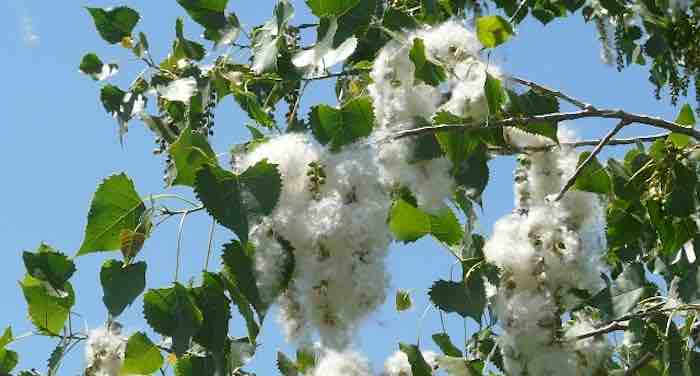 Trees ensure distribution of their seeds in many ingenious ways. Maples and ash produce whirring propellers; oaks drop acorns; apples tasty fruit. Then there is the Eastern Cottonwood, Populus deltoides. It packs tiny seeds in billows of white fluff. These drift the wind to optimistically fall on fertile soil in an acceptable location. And, as with most such tree prolific productions, almost none succeed.
The creation of such is the responsibility of female trees, for the Eastern Cottonwood is dioecious, having separate male and female trees. It is also known as Carolina Poplar, Southern Cottonwood, Plains Cottonwood, Yellow Cottonwood, Big Cottonwood, Whitewood, and Necklace Poplar. Botanists also argue over the trees which, like all Populus, hybridize gleefully. This does nothing for the botanically-inclined state of mind. They do agree, however, Fremont Cottonwood, Populus fremontii, is a distinct species. Named after explorer of the western United States John Charles Fremont the tree grew in a grove where Spanish settlers in 1836 founded a mission called Alamo.
Trees ensure distribution of their seeds in many ingenious ways. Maples and ash produce whirring propellers; oaks drop acorns; apples tasty fruit. Then there is the Eastern Cottonwood, Populus deltoides. It packs tiny seeds in billows of white fluff. These drift the wind to optimistically fall on fertile soil in an acceptable location. And, as with most such tree prolific productions, almost none succeed.
The creation of such is the responsibility of female trees, for the Eastern Cottonwood is dioecious, having separate male and female trees. It is also known as Carolina Poplar, Southern Cottonwood, Plains Cottonwood, Yellow Cottonwood, Big Cottonwood, Whitewood, and Necklace Poplar. Botanists also argue over the trees which, like all Populus, hybridize gleefully. This does nothing for the botanically-inclined state of mind. They do agree, however, Fremont Cottonwood, Populus fremontii, is a distinct species. Named after explorer of the western United States John Charles Fremont the tree grew in a grove where Spanish settlers in 1836 founded a mission called Alamo.The Comment section of online publications is the new front in the ongoing Cancel Culture Battle.
Big Tech and Big Media are gunning for the Conservative Voice—through their Comment Sections.
Canada Free Press wishes to stay in the fight, and we want our fans, followers, commenters there with us.
We ask only that commenters keep it civil, keep it clean.
Thank You for your patience and for staying aboard the CFP ‘Mother Ship’.
READ OUR Commenting Policy